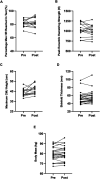Lessons from the COVID-19 pandemic: Insights into effective training strategies for physical development in football
- PMID: 38603107
- PMCID: PMC9014339
- DOI: 10.1177/17479541221081782
Lessons from the COVID-19 pandemic: Insights into effective training strategies for physical development in football
Abstract
Professional soccer players typically perform regular training sessions and match play for most of the yearly macrocycle with limited time focused on solely developing physical development. The COVID-19 outbreak in 2020 caused mass disruption to professional soccer but provided an opportunity for an alternative approach to training in attempt to develop professional soccer players physical fitness levels. In a non-randomised and non-controlled study, we aimed to assess the effectiveness of a 13-week remote based physical training programme on physical fitness levels in elite professional soccer players. Twenty professional soccer players undertook body composition assessments, a countermovement jump (CMJ) test, eccentric hamstring strength test and a submaximal 30-15 intermittent fitness test (IFT) pre- and post-remote based training programme. Body mass (79.3 ± 6.7 vs. 80.0 ± 7.3 kg), skinfold thickness (54.1 ± 14.8 vs. 56.7 ± 15.2 mm), maximum CMJ height (38.4 ± 3.4 vs. 40.9 ± 4.1 cm), eccentric hamstring strength (1035 ± 158 vs. 1009 ± 140 n) and percentage max heart rate reached in submaximal 30-15 IFT (81.3 ± 5.2 vs. 82.3 ± 7.3%) were maintained (all P > 0.05) from pre- to post training programme, respectively. Although team-based soccer specific training load was removed, and the training programmes prescribed had an increased physical focus, fitness levels were maintained. This suggests that alternative modes of training can potentially be used in instances where team-based soccer specific training load isn't required or is unavailable, without negatively impacting physical development.
Keywords: Anthropometry; eccentric muscle action; hamstring strength; heart rate; soccer.
© The Author(s) 2022.
Figures



Similar articles
-
Sprint and jump performance in elite male soccer players following a 10-week Nordic Hamstring exercise Protocol: a randomised pilot study.BMC Res Notes. 2017 Dec 4;10(1):669. doi: 10.1186/s13104-017-2986-x. BMC Res Notes. 2017. PMID: 29202784 Free PMC article.
-
Effects of Different Plyometric Training Frequencies on Components of Physical Fitness in Amateur Female Soccer Players.Front Physiol. 2018 Jul 17;9:934. doi: 10.3389/fphys.2018.00934. eCollection 2018. Front Physiol. 2018. PMID: 30065665 Free PMC article.
-
The effect of a concentrated period of soccer-specific fitness training with small-sided games on physical fitness in youth players.J Sports Med Phys Fitness. 2019 Jun;59(6):962-968. doi: 10.23736/S0022-4707.18.08547-X. Epub 2018 Jun 27. J Sports Med Phys Fitness. 2019. PMID: 29952179
-
Hematology, Hormones, Inflammation, and Muscle Damage in Elite and Professional Soccer Players: A Systematic Review with Implications for Exercise.Sports Med. 2021 Dec;51(12):2607-2627. doi: 10.1007/s40279-021-01522-w. Epub 2021 Aug 4. Sports Med. 2021. PMID: 34347283
-
Broad-spectrum physical fitness benefits of recreational football: a systematic review and meta-analysis.Br J Sports Med. 2019 Aug;53(15):926-939. doi: 10.1136/bjsports-2017-097885. Epub 2018 Jan 25. Br J Sports Med. 2019. PMID: 29371223 Free PMC article.
References
-
- Morgans R, Orme P, Anderson L, et al.Principles and practices of training for soccer. J Sport Health Sci 2014; 3: 251–257.
-
- Silva JR, Brito J, Akenhead R, et al.The transition period in soccer: a window of opportunity. Sports Med 2016; 46: 305–313. - PubMed
-
- Walker G, Hawkins R. Structuring a program in elite professional soccer. Strength Cond J 2017; 40: 1.
-
- Hoff J, Helgerud J. Endurance and strength training for soccer players: physiological considerations. Sports Med 2004; 34: 165–180. - PubMed
-
- Anderson L, Orme P, Di Michele R, et al.Quantification of training load during one-, two- and three-game week schedules in professional soccer players from the English Premier League: implications for carbohydrate periodisation. J Sports Sci 2016; 34: 1250–1259. - PubMed
LinkOut - more resources
Full Text Sources
